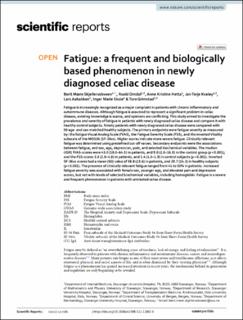| dc.contributor.author | Skjellerudsveen, Berit Mære | |
| dc.contributor.author | Omdal, Roald | |
| dc.contributor.author | Hetta, Anne Kristine | |
| dc.contributor.author | Kvaløy, Jan Terje | |
| dc.contributor.author | Aabakken, Lars | |
| dc.contributor.author | Skoie, Inger Marie | |
| dc.contributor.author | Grimstad, Tore Bjørn | |
| dc.date.accessioned | 2022-10-25T11:02:14Z | |
| dc.date.available | 2022-10-25T11:02:14Z | |
| dc.date.created | 2022-10-11T08:27:52Z | |
| dc.date.issued | 2022 | |
| dc.identifier.issn | 2045-2322 | |
| dc.identifier.uri | https://hdl.handle.net/11250/3028170 | |
| dc.description.abstract | Fatigue is increasingly recognized as a major complaint in patients with chronic inflammatory and autoimmune diseases. Although fatigue is assumed to represent a significant problem in celiac disease, existing knowledge is scarce, and opinions are conflicting. This study aimed to investigate the prevalence and severity of fatigue in patients with newly diagnosed celiac disease and compare it with healthy control subjects. Ninety patients with newly diagnosed celiac disease were compared with 90 age- and sex-matched healthy subjects. The primary endpoints were fatigue severity as measured by: the fatigue Visual Analog Scale (fVAS), the Fatigue Severity Scale (FSS), and the inverted Vitality subscale of the MOS36 (SF-36vs). Higher scores indicate more severe fatigue. Clinically relevant fatigue was determined using predefined cut-off values. Secondary endpoints were the associations between fatigue, and sex, age, depression, pain, and selected biochemical variables. The median (IQR) fVAS-scores were 43.0 (18.0–64.5) in patients, and 9.0 (2.0–16.0) in the control group (p < 0.001); and the FSS scores 3.8 (2.0–4.8) in patients, and 1.4 (1.0–1.9) in control subjects (p < 0.001). Inverted SF-36vs scores had a mean (SD) value of 58.8 (23.6) in patients, and 29.7 (14.3) in healthy subjects (p < 0.001). The presence of clinically relevant fatigue ranged from 41 to 50% in patients. Increased fatigue severity was associated with female sex, younger age, and elevated pain and depression scores, but not with levels of selected biochemical variables, including hemoglobin. Fatigue is a severe and frequent phenomenon in patients with untreated celiac disease. | en_US |
| dc.language.iso | eng | en_US |
| dc.publisher | Nature | en_US |
| dc.rights | Navngivelse 4.0 Internasjonal | * |
| dc.rights.uri | http://creativecommons.org/licenses/by/4.0/deed.no | * |
| dc.title | Fatigue: a frequent and biologically based phenomenon in newly diagnosed celiac disease | en_US |
| dc.type | Journal article | en_US |
| dc.type | Peer reviewed | en_US |
| dc.description.version | publishedVersion | en_US |
| dc.rights.holder | Copyright 2022 The Author(s) | en_US |
| dc.source.articlenumber | 7281 | en_US |
| cristin.ispublished | true | |
| cristin.fulltext | original | |
| cristin.qualitycode | 1 | |
| dc.identifier.doi | 10.1038/s41598-022-11802-8 | |
| dc.identifier.cristin | 2060283 | |
| dc.source.journal | Scientific Reports | en_US |
| dc.identifier.citation | Scientific Reports. 2022, 12, 7281. | en_US |
| dc.source.volume | 12 | en_US |

